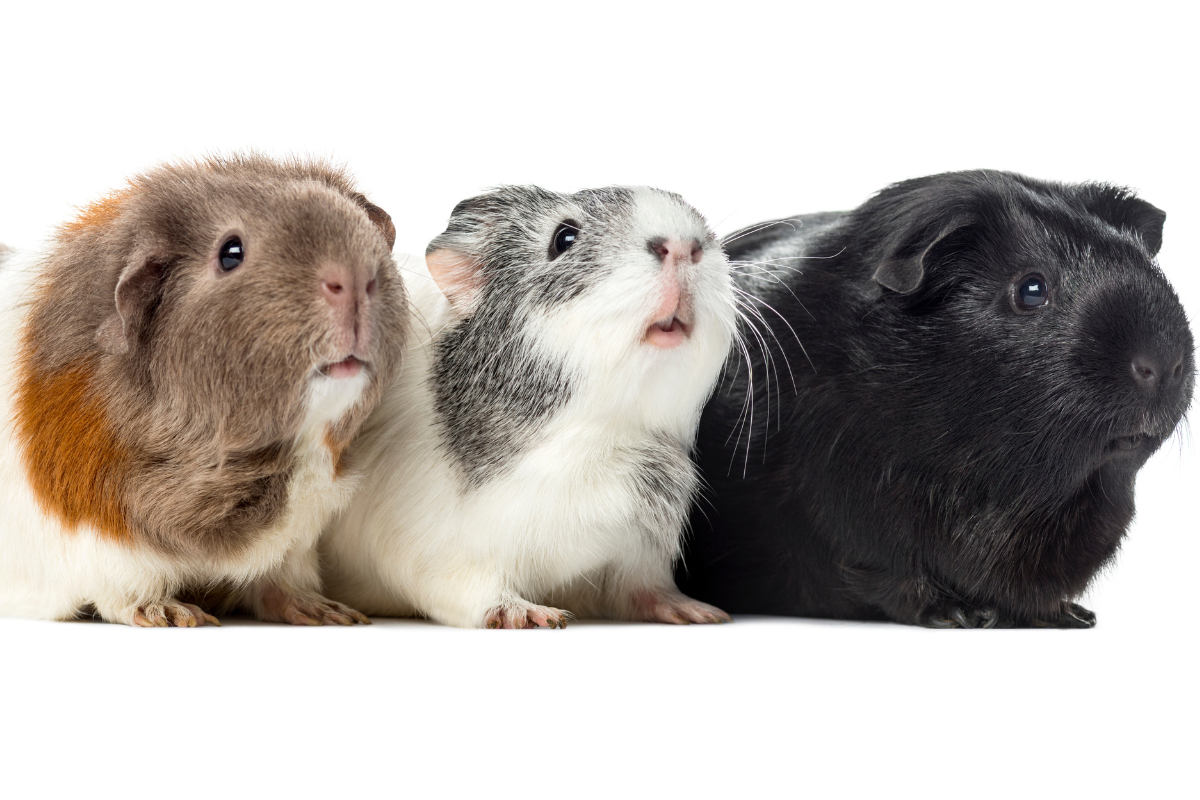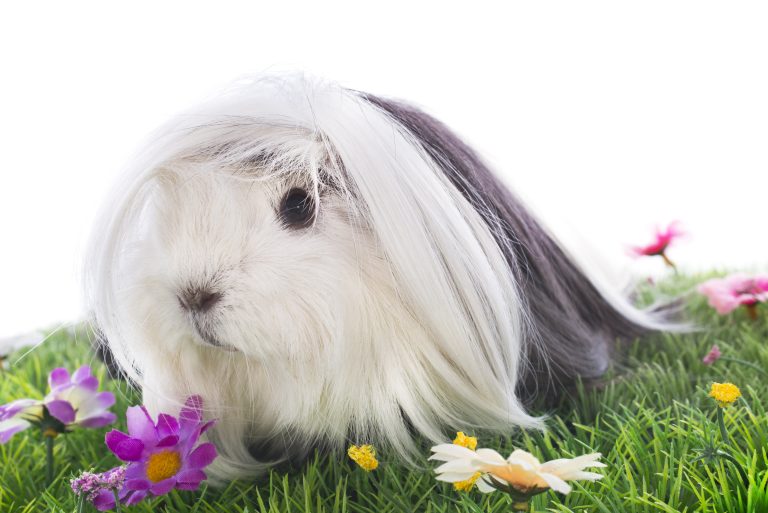The Ultimate List of all Guinea Pig Breeds
Guinea pigs can make great companions for both children and adults. This is the ultimate list of all guinea pig breeds and varieties available!
Guinea pigs are snuggly and affectionate and make amazing pets.
For years, guinea pigs have been kept as companions by people all over the world. Over time many different breeds and varieties have evolved. From colours, hair types, and temperaments, different breeds of guinea pigs offer different attributes.
So which is the best for your family or what type of guinea pig do you already have?
Let’s find out!
The Ultimate List of all Guinea Pig Breeds
There are many different guinea pig breeds and hair varieties.
Guinea pigs are social animals and thrive when they have company. They are generally quiet and do not require as much exercise as other pets, such as dogs. This makes them a popular choice when families are considering a new pet.
But which breed is best?
Here is a detailed and complete guide to the different varieties of floofy fuzz potatoes around the world today.
How Many Breeds of Guinea Pigs Are There?
There are many breeds of guinea pigs, and the exact number can vary depending on different breed standards and classifications.
The American Cavy Breeders Association (ACBA) officially recognizes 13 breeds of guinea pigs:
- Abyssinian
- American
- Coronet
- Peruvian
- Silkie
- Teddy
- Texel
- White Crested
- Skinny
- Baldwin
- Merino
- Lunkarya
- Sheba Mini Yak
There are also other breeds and variations that are not officially recognized by the ACBA. These are still commonly kept as pets, such as the Himalayan, Rex, and Satin.
Additionally, there are different coat patterns and colors that can occur within each breed. The total number of guinea pig variations is quite vast.
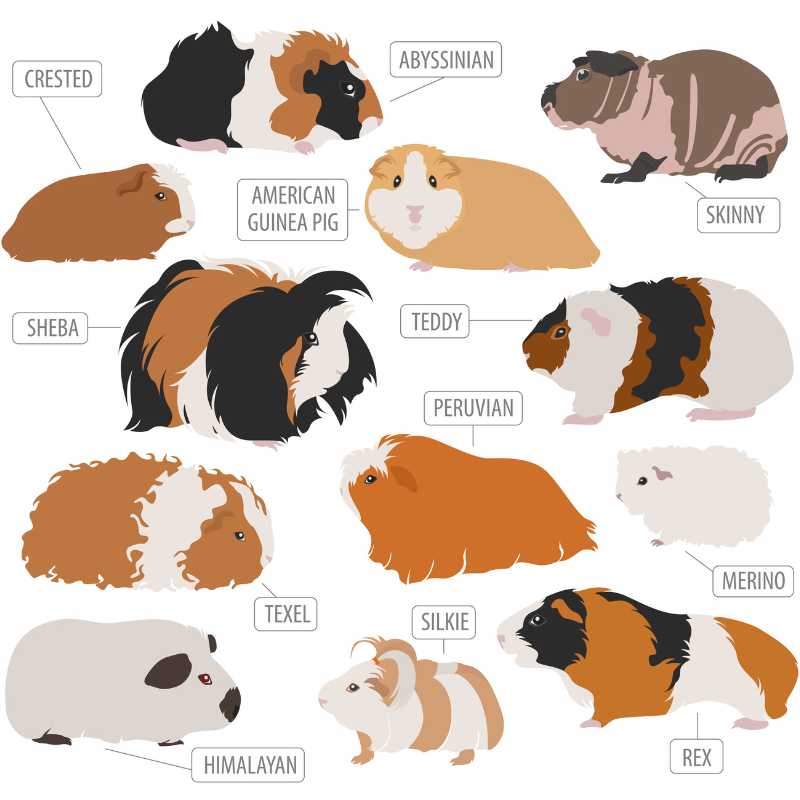
Popular Recognized Guinea Pig Breeds
There are many different breeds of guinea pigs, each with its own unique characteristics and appearances. Here are some of the most common breeds:
Abyssinian Guinea Pigs
Abyssinian guinea pigs are a popular breed known for their distinctive and unique coat pattern. Their coat is made up of short, rough hair that grows in a rosette pattern, with several whorls or cowlicks. This hair growth pattern creates a spikey and textured appearance. The coat comes in a variety of colors, such as:
- white
- black
- brown
- red
- brindle
- tortoiseshell
Abyssinian guinea pigs are typically medium-sized, weighing between 680 to 1134 grams (1.5 to 2.5 pounds). They have a round, compact body shape. Abyssinian guinea pigs have friendly and outgoing personalities. They enjoy interacting with humans, often “popcorning” or jumping when they are excited. They do well in pairs or small groups and require regular socialization and playtime to keep them happy and healthy.
In terms of care, Abyssinian guinea pigs require a clean and spacious living environment. Fresh water, a balanced diet of hay, fresh vegetables, and pellets should be readily available for your guinea pigs. They also require regular grooming to maintain their unique coat, as it can easily become matted or tangled. They have a lifespan of around 5 to 7 years with proper care.
Overall, Abyssinian guinea pigs make great pets. They suit those looking for a unique and interesting pet with a friendly and outgoing personality. They are also a good option for those who enjoy grooming and spending time with their pets.

American Guinea Pigs
The American guinea pig is one of the most common breeds of guinea pig. They are known for their smooth, short coat that lies flat against its body. They are typically medium-sized, weighing between 680 to 1134 grams (1.5 to 2.5 pounds). American guinea pigs have a round, compact body shape.
American guinea pigs come in a variety of colors and patterns, including:
- white
- black
- cream
- red
- combinations of the above colours
- tortoiseshell
- brindle
In terms of temperament, American guinea pigs are generally friendly and social animals that enjoy human interaction. They are easy to handle and do well in pairs or small groups. They require regular socialization and playtime to keep them happy and healthy.
American guinea pigs are relatively low-maintenance pets and require a clean and spacious living environment. They need a ready supply of fresh water, and a balanced diet of hay, fresh vegetables, and pellets. They have a lifespan of around 5 to 7 years with proper care.
Overall, American guinea pigs make great pets for first-time pet owners or families with children. They are generally easy to care for and have a gentle and friendly temperament.
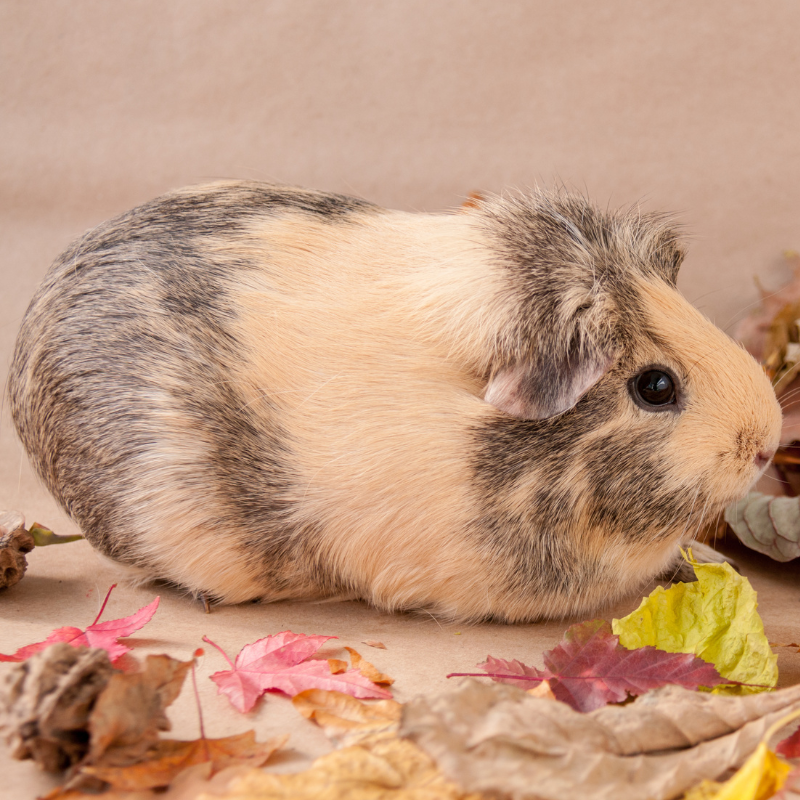
Coronet Guinea Pigs
Coronet guinea pigs are a breed known for their long, flowing coat and distinctive crest of hair on their forehead. The coat is made up of long, straight hair that can come in a variety of colors and patterns. These include white, black, brown, and red.
The crest of hair on their forehead is typically a different color than the rest of their coat.
Coronet guinea pigs are typically medium-sized, weighing between 680 to 1134 grams (1.5 to 2.5 pounds). Coronets usually have a round, compact body shape.
They have friendly and outgoing personalities and enjoy interacting with humans. They do well in pairs or small groups and require regular socialization and playtime to keep them happy and healthy.
In terms of care, Coronet guinea pigs require a clean and spacious living environment. Coronets need a ready supply of fresh water, and a balanced diet of hay, fresh vegetables, and pellets.
They also require regular grooming to prevent tangling and matting of their long coat. Without regular grooming, their coat can become uncomfortable and lead to health problems.
Coronet guinea pigs have a lifespan of around 5 to 7 years with proper care. They make great pets for those who enjoy grooming and spending time with their pets. They make unique and interesting pets with friendly and outgoing personalities.

Peruvian Guinea Pigs
Peruvian guinea pigs are a breed known for their long, flowing coats. These luscious coats can grow up to 50 cm (20 inches) in length. The coat is made up of fine, silky hair that requires regular grooming to prevent tangling and matting.
The coat comes in a variety of colours, such as:
- white
- black
- brown
- red
- brindle
- tortoiseshell
Peruvian guinea pigs are typically medium-sized, weighing between 680 to 1134 grams (1.5 to 2.5 pounds). Peruvians have slender, elongated body shapes. They have friendly and outgoing personalities and enjoy interacting with humans. They do well in pairs or small groups and require regular socialization and playtime to keep them happy and healthy.
In terms of care, Peruvian guinea pigs require a clean and spacious living environment. They need fresh water, and a balanced diet of hay, fresh vegetables, and pellets. They also require daily grooming to maintain their long coat, which can be time-consuming. Without regular grooming, their coat can become matted and uncomfortable, leading to health problems.
Peruvian guinea pigs have a lifespan of around 5 to 7 years with proper care. They make great pets for those who enjoy grooming and spending time with their pets. Peruvian guinea pigs make unique and interesting pets with friendly and outgoing personalities.
Learn more about the super floofy Peruvian Guinea Pig here!

Silkie Guinea Pigs
Silkie guinea pigs are a breed known for their long, soft, and silky coat that is pleasant to touch. Their coat is similar to the Peruvian guinea pig, but the hair is shorter and less prone to tangling. The coat can come in a variety of colors, including white, black, brown, and red, and can have different patterns, such as brindle, tortoiseshell, and solid colors.
Silkie guinea pigs are typically small to medium-sized. On the scales, silkies weigh between 454 to 1134 grams (1 to 2.5 pounds), and have a round, compact body shape. They have a friendly and outgoing personalities and enjoy interacting with humans. They do well in pairs or small groups and require regular socialization and playtime to keep them happy and healthy.
Silkie guinea pigs require a clean and spacious living environment. A ready supply of fresh water, and a balanced diet of hay, fresh vegetables, and pellets will help keep them healthy. They also require regular grooming to maintain their long and soft coat. Without regular grooming, their coat can become uncomfortable and lead to health problems.
Silkie guinea pigs have a lifespan of around 5 to 7 years with proper care. They make great pets for those who enjoy grooming and spending time with their pets.

Teddy Guinea Pigs
Teddy guinea pigs are a breed known for their dense and curly coat that resembles a teddy bear. The hair is thick and has a woolly texture that provides a plush appearance.
The coat comes in a variety of colors, such as:
- white
- black
- brown
- red
- brindle
- tortoiseshell
Teddy guinea pigs are typically small to medium-sized, weighing between 454 to 1134 grams (1 to 2.5 pounds). Teddy guinea pigs have a round, compact body shape. They have friendly and curious personalities and enjoy interacting with humans. They do well in pairs or small groups and require regular socialization and playtime to keep them happy and healthy.
In terms of care, Teddy guinea pigs require a clean and spacious living environment. Teddy guinea pigs require fresh water, and a balanced diet of hay, fresh vegetables, and pellets. They also require daily grooming to maintain their dense coat, which can easily become matted or tangled. Without regular grooming, their coat can become uncomfortable, leading to health problems.
Teddy guinea pigs have a lifespan of around 4 to 6 years with proper care. They make great pets for those who enjoy spending time with their pets. Teddy guinea pigs are unique and interesting pets. Their thick coat requires more attention to grooming than some other breeds. For this reason, they may not be the best choice for first-time guinea pig owners.
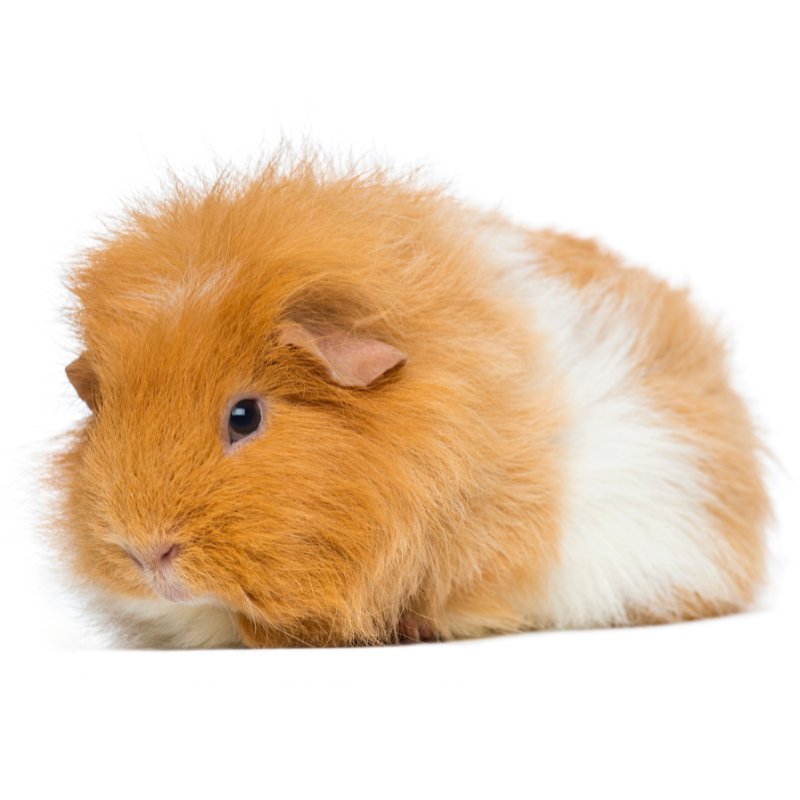
Texel Guinea Pigs
Texel guinea pigs are a breed known for their long, curly coat, which resembles sheep’s wool. The coat is soft, and dense, and can come in a variety of colors, including white, black, brown, and red. The curls of their coat can be tight or loose, and their hair can grow up to 4-6 inches long.
Texel guinea pigs are typically small to medium-sized, weighing between 680 to 1360 grams (1.5 to 3 pounds). Texel guinea pigs have a round, compact body shape. They have friendly and outgoing personalities and enjoy interacting with humans. They do well in pairs or small groups and require regular socialization and playtime to keep them happy and healthy.
In terms of care, Texel guinea pigs require a clean and spacious living environment. Texel guinea pigs require fresh water, and a balanced diet of hay, fresh vegetables, and pellets. They also require regular grooming to prevent tangling and matting of their long, curly coat. Without regular grooming, their coat can become uncomfortable and lead to health problems.
Texel guinea pigs have a lifespan of around 5 to 7 years with proper care. They make great pets for those who enjoy grooming and spending time with their pets. Texels make a unique and interesting pets with a friendly and outgoing personalities.

White Crested Guinea Pig
White Crested guinea pigs are a breed known for their distinctive white crest of hair on top of their head. This is often accompanied by a white blaze on their nose.
Their coat can come in a variety of colors, including:
- white
- black
- brown
- red
A white crest is the distinguishing characteristic of the breed.
White Crested guinea pigs are typically small to medium-sized. They weigh between 680 to 1134 grams (1.5 to 2.5 pounds) and have a compact body shape. They have friendly and outgoing personalities and enjoy interacting with humans. White-crested guinea pigs do well in pairs or small groups and require regular socialization and playtime to keep them happy and healthy.
In terms of care, White Crested guinea pigs require a clean and spacious living environment, fresh water, and a balanced diet of hay, fresh vegetables, and pellets. They do not require extensive grooming, but the white crest may need occasional trimming to maintain its shape. Without proper care, their coat can become uncomfortable and lead to health problems.
White Crested guinea pigs have a lifespan of around 5 to 7 years with proper care. They make great pets for those looking for a unique and interesting breed with a friendly and outgoing personality.
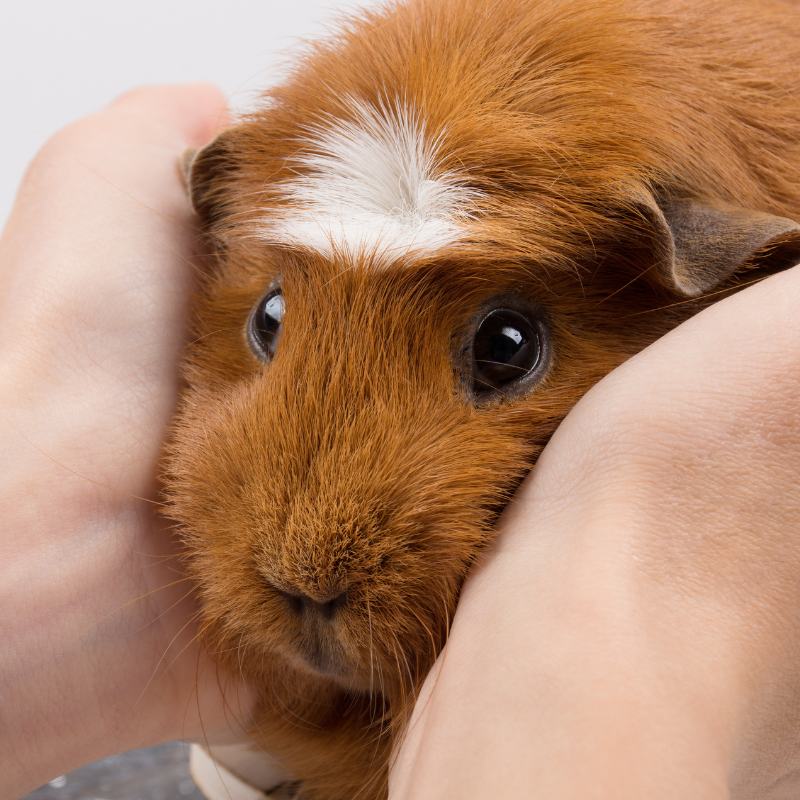
Skinny Guinea Pigs
Skinny pigs are a breed of guinea pig that is unique in that they have very little hair, except for a small amount on their nose and feet. They are also sometimes referred to as “hairless guinea pigs” or “naked guinea pigs.” Just quietly I think they look like little mini hippos.
Their skin is soft and smooth and can come in a variety of colors and patterns, such as:
- pink
- black
- white.
Skinny pigs are typically small to medium-sized, weighing between 1.5 to 2.5 pounds (680 to 1134 grams), and have a round, compact body shape. They have friendly and outgoing personalities and enjoy interacting with humans. Skinny pigs do well in pairs or small groups and require regular socialization and playtime to keep them happy and healthy.
In terms of care, skinny pigs require a clean and spacious living environment, fresh water, and a balanced diet of hay, fresh vegetables, and pellets. Because they have little to no hair, they are more sensitive to temperature changes and require special attention to keep them warm in cooler climates. They also require regular skin care, such as weekly baths and the application of a gentle moisturizer to prevent dryness and flakiness.
Skinny pigs have a lifespan of around 5 to 8 years with proper care. They make great pets for those who enjoy spending time with their pets and for those looking for a unique and interesting pet with a friendly and outgoing personality. However, their unique hairless appearance and special care requirements may not make them the best choice for first-time guinea pig owners.
Unfortunately, skinny pigs are not currently available in Australia.
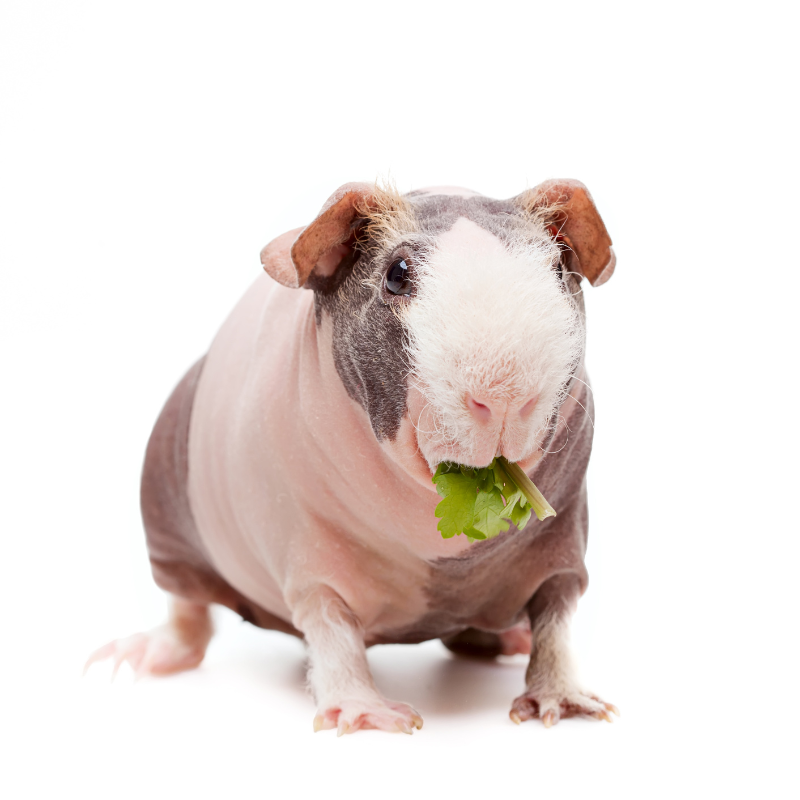
Baldwin Guinea Pig
The Baldwin guinea pig, also known as the “Baldwin’s hairless guinea pig”, is a unique breed of guinea pig that is completely hairless. They are the result of a genetic mutation that affects hair growth, and as a result, they lack the typical fur of a guinea pig.
Baldwin guinea pigs have smooth, pink skin that is prone to dryness and sunburn. They require a warm and dry living environment, as they are sensitive to cold temperatures. They also require regular baths and moisturizing to keep their skin healthy and comfortable.
In terms of personality, Baldwin guinea pigs are known for their friendly and social nature. Baldwin guinea pigs do well in pairs or small groups and require regular socialization and playtime to keep them happy and healthy.
In terms of care, Baldwin guinea pigs require a clean and spacious living environment, fresh water, and a balanced diet of hay, fresh vegetables, and pellets. They also require regular grooming to maintain their skin health, including baths and moisturizing.
Baldwin guinea pigs have a lifespan of around 5 to 7 years with proper care. They make great pets for those looking for a unique and interesting breed with a friendly and social personality, but they do require specialized care due to their hairless nature.
Merino Guinea Pigs
The Merino guinea pig is a breed known for its long, curly fur, which gives them a unique and distinctive appearance. They are a medium-sized breed, weighing between 680 to 1134 grams (1.5 to 2.5 pounds), and have a compact body shape.
Merino guinea pigs are known for their friendly and outgoing personality and enjoy interacting with humans. Curly-haired Merino guinea pigs do well in pairs or small groups and require regular socialization and playtime to keep them happy and healthy.
In terms of care, Merino guinea pigs require a clean and spacious living environment, fresh water, and a balanced diet of hay, fresh vegetables, and pellets. They also require regular grooming to maintain their long and curly coat, including brushing and trimming to prevent matting and discomfort.
Merino guinea pigs have a lifespan of around 5 to 7 years with proper care. They make great pets for those looking for a unique and interesting breed with a friendly and outgoing personality, but they do require regular grooming to maintain their long and curly coat.

Lunkarya Guinea Pigs
Lunkarya guinea pigs are a breed known for their unique and distinctive coat, which is long and curly with a “frizzy” texture. The coat can come in a variety of colors, including white, black, brown, and red, and has a woolly appearance that makes them resemble a miniature sheep or a poodle.
Lunkarya guinea pigs are typically small to medium-sized, weighing between 680 to 1134 grams (1.5 to 2.5 pounds), and have a round, compact body shape. They have friendly and outgoing personalities and enjoy interacting with humans. Lunkarya guinea pigs do well in pairs or small groups and require regular socialization and playtime to keep them happy and healthy.
In terms of care, Lunkarya guinea pigs require a clean and spacious living environment, fresh water, and a balanced diet of hay, fresh vegetables, and pellets. They also require regular grooming to maintain their unique coat. Without regular grooming, their coat can become uncomfortable and lead to health problems.
Lunkarya guinea pigs have a lifespan of around 5 to 7 years with proper care. They make great pets for those who enjoy grooming and spending time with their pets, and for those looking for a unique and interesting pet with a friendly and outgoing personality.
Sheba Mini Yak
The Sheba Mini Yak guinea pig is a relatively new and rare breed that originates from South America. They are a small breed, weighing between 453 to 680 grams (1 to 1.5 pounds), and have a compact body shape.
The Mini Yak guinea pig is known for its unique coat, which is long, thick, and curly. The coat is made up of both soft and coarse hair, and comes in a variety of colors, including black, white, and golden.
In terms of personality, the Mini Yak guinea pig is known for being friendly and curious. They enjoy interacting with humans and do well in pairs or small groups.
In terms of care, Mini Yak guinea pigs require a clean and spacious living environment, fresh water, and a balanced diet of hay, fresh vegetables, and pellets. They also require regular grooming to maintain their long and curly coat, including brushing and trimming to prevent matting and discomfort.
Mini Yak guinea pigs have a lifespan of around 5 to 7 years with proper care. They make great pets for those looking for a unique and interesting breed with a friendly and curious personality, but they do require regular grooming to maintain their long and curly coat.
Sheltie Guinea Pigs
Sheltie guinea pigs, also known as Sheltland guinea pigs or “miniature Lassies,” are a breed known for their long, smooth coat that is parted down the middle of their back, resembling the coat of a Shetland pony. Their coat can come in a variety of colors, including white, black, brown, and red, and can have different patterns, such as tortoiseshell, brindle, and solid colors.
Sheltie guinea pigs are typically small to medium-sized, weighing between 680 to 1360 grams (1.5 to 3 pounds), and have a lean, elongated body shape. They have friendly and outgoing personalities and enjoy interacting with humans. Shelties do well in pairs or small groups and require regular socialization and playtime to keep them happy and healthy.
In terms of care, Sheltie guinea pigs require a clean and spacious living environment, fresh water, and a balanced diet of hay, fresh vegetables, and pellets. They also require regular grooming to maintain their long and smooth coat, which can tangle and mat if left ungroomed. Without regular grooming, their coat can become uncomfortable and lead to health problems.
Sheltie guinea pigs have a lifespan of around 5 to 7 years with proper care. They make great pets for those who enjoy grooming and spending time with their pets, and for those looking for a unique and interesting pet with a friendly and outgoing personality.
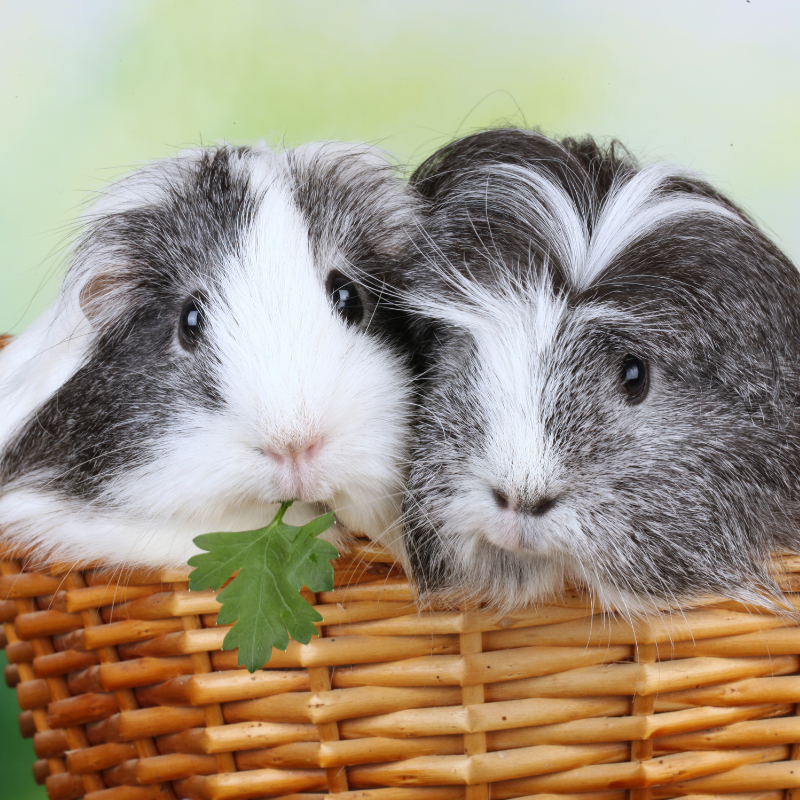
Examples of Unrecognized Guinea Pig Breeds
Alpaca guinea pig
Alpaca guinea pigs are different from other guinea pig breeds primarily due to their long and straight coat, which gives them a unique and distinct appearance. Their coat is different from other breeds, which typically have shorter, curly or straight hair.
Additionally, Alpaca guinea pigs are typically larger in size than many other guinea pig breeds, weighing between 907 to 1361 grams (2 to 3 pounds) on average. They have a slender body shape, with longer legs and a more elongated snout compared to some other breeds.
In terms of personality, Alpaca guinea pigs are known for being calm and gentle. They enjoy interacting with humans and can make great pets for those looking for a more laid-back and mellow guinea pig. However, as with all guinea pigs, they require regular socialization and playtime to keep them healthy and happy.
Overall, the primary differences between Alpaca guinea pigs and other breeds are their long and straight coat, larger size, and more laid-back personality.
Rex guinea pig
Rex guinea pigs are different from other guinea pig breeds primarily due to their unique fur coat, which has a dense, plush, and velvety texture. Their fur is short and curly, with no guard hairs, which gives them a unique and distinctive appearance.
Additionally, Rex guinea pigs are typically smaller in size than many other guinea pig breeds, weighing between 680 to 1134 grams (1.5 to 2.5 pounds) on average. They have a rounded body shape, with short legs and a compact head.
In terms of personality, Rex guinea pigs are known for being friendly and curious. They enjoy interacting with humans and can make great pets for those looking for a more active and playful guinea pig. However, as with all guinea pigs, they require regular socialization and playtime to keep them healthy and happy.
Overall, the primary differences between Rex guinea pigs and other breeds are their unique fur coat, smaller size, and more active and playful personality.
Ridgeback guinea pig
Ridgeback guinea pigs, also known as Teddy Ridgeback, are different from other guinea pig breeds primarily due to their distinctive ridged fur. Their fur is longer and curly, with ridges that run down the center of their back, which gives them a unique and distinctive appearance.
Additionally, Ridgeback guinea pigs are typically larger in size than many other guinea pig breeds, weighing between 907 to 1361 grams (2 to 3 pounds) on average. They have a round body shape, with short legs and a broad head.
In terms of personality, Ridgeback guinea pigs are known for being friendly and outgoing. They enjoy interacting with humans and can make great pets for those looking for a more social and active guinea pig. However, as with all guinea pigs, they require regular socialization and playtime to keep them healthy and happy.
Overall, the primary differences between Ridgeback guinea pigs and other breeds are their distinctive ridged fur, larger size, and outgoing personality.
Rare Breeds of Guinea Pigs
Brazilian Guinea Pigs
The Brazilian guinea pig (Cavia aperea) is a species of guinea pig that is found in the wild in several countries in South America, including Brazil. It is also known by other common names such as the “restinga guinea pig” and the “southern mountain guinea pig”.
Unlike domestic guinea pigs, which have been selectively bred for many generations and have lost some of their wild characteristics, Brazilian guinea pigs have a number of physical and behavioral differences. One of the key differences is that they have a tiny, barely there tail. While domestic guinea pigs typically have no tails at all, Brazilian guinea pigs have short tails.
In terms of behavior, Brazilian guinea pigs are more skittish and nervous than domestic guinea pigs, which have been socialized to be more docile and friendly around humans. They are also more active and require more space to move around than domestic guinea pigs, which have been selectively bred for smaller body sizes.
It is worth noting that Brazilian guinea pigs are wild animals and are not typically kept as pets. They are an important part of the local ecology in their native habitats, playing a role in seed dispersal and providing food for predators such as birds of prey, foxes, and snakes.
Montane Guinea Pigs
Montane guinea pigs, also known as Andean guinea pigs or Cavia tschudii, are a species of guinea pig native to the Andes mountains of South America. They are a wild species and not typically kept as pets, unlike the domestic guinea pig species commonly kept as pets.
Montane guinea pigs have a distinct appearance compared to domestic guinea pig breeds. They have longer legs and a more slender body shape, with shorter, rougher fur that is typically brownish-gray or grayish-brown in color. They also have a distinctive white patch on their forehead, which is a characteristic feature of the species.
In their natural habitat, Montane guinea pigs are typically found at higher elevations, living in rocky areas and grasslands. They are herbivorous, feeding primarily on grasses and other vegetation.
While Montane guinea pigs are not kept as pets, they have been studied extensively by scientists due to their unique adaptation to high-altitude environments and are an important part of the ecological system of the Andes mountains.
Shiny Guinea Pigs
The shiny guinea pig, or Galea musteloides, is a species of guinea pig that is found in the wild in several countries in South America, including Brazil, Argentina, and Paraguay. They are also sometimes referred to as the “forest guinea pig” due to their preference for forested habitats.
Shiny guinea pigs are typically dark brown or black in color, with a glossy or shiny coat that is dense and soft. They have a stocky body and short legs, and they can grow up to about 25 centimeters in length. They are herbivorous, primarily feeding on grasses, herbs, and other vegetation.
In the wild, shiny guinea pigs are often found in small groups or pairs, and they are active during the day, spending much of their time foraging for food. They are also known for their vocalizations, which they use to communicate with each other and to warn of potential threats.
While shiny guinea pigs are not typically kept as pets, they are an important part of the local ecology in their native habitats, playing a role in seed dispersal and providing food for predators such as birds of prey, foxes, and snakes.
Santa Catarina’s Guinea Pig
The Santa Catarina guinea pig (Cavia intermedia) is a species of guinea pig that is native to parts of Brazil and Argentina, and it is known for its distinctive black and white coat.
The Santa Catarina guinea pig is a medium-sized guinea pig, with a body length of up to around 25 centimeters. Its coat is black on the top half of its body, and white on the bottom half, with a clear line of demarcation between the two colors. The eyes and ears are relatively large, and the legs are short but strong.
In the wild, Santa Catarina guinea pigs live in a range of habitats, from forests to grasslands. They are herbivorous, feeding primarily on grasses and other vegetation. They are also social animals, typically living in groups of two to five individuals.
While Santa Catarina guinea pigs are not commonly kept as pets, they are sometimes bred in captivity for research purposes. In the wild, they are threatened by habitat loss due to deforestation and agriculture, as well as by predation from a range of predators including birds of prey, snakes, and carnivorous mammals.
Guinea Pig Colours
Guinea pigs come in a variety of colours and patterns, and there are many different combinations that can occur.
If you are interested in adopting a guinea pig with a particular coloring or pattern, it is best to work with a reputable breeder or rescue organization that can help you find the right match.
Some of the most common colors and patterns include:
Agouti
Agouti is a common coloring in guinea pigs that features a mixture of brown, black, and white hairs in a specific pattern. The individual hairs on an agouti guinea pig are banded with different colors, giving the animal a slightly speckled appearance. This coloring is similar to that of many wild rodents, such as the agouti, from which it takes its name.
There are several different variations of agouti coloring in guinea pigs, including golden, cinnamon, and silver agouti. These variations have slightly different coloration patterns and shades of brown, black, and white, but all feature the characteristic banded hairs. Agouti is a common and popular coloring in guinea pigs and is found in many different breeds and varieties.
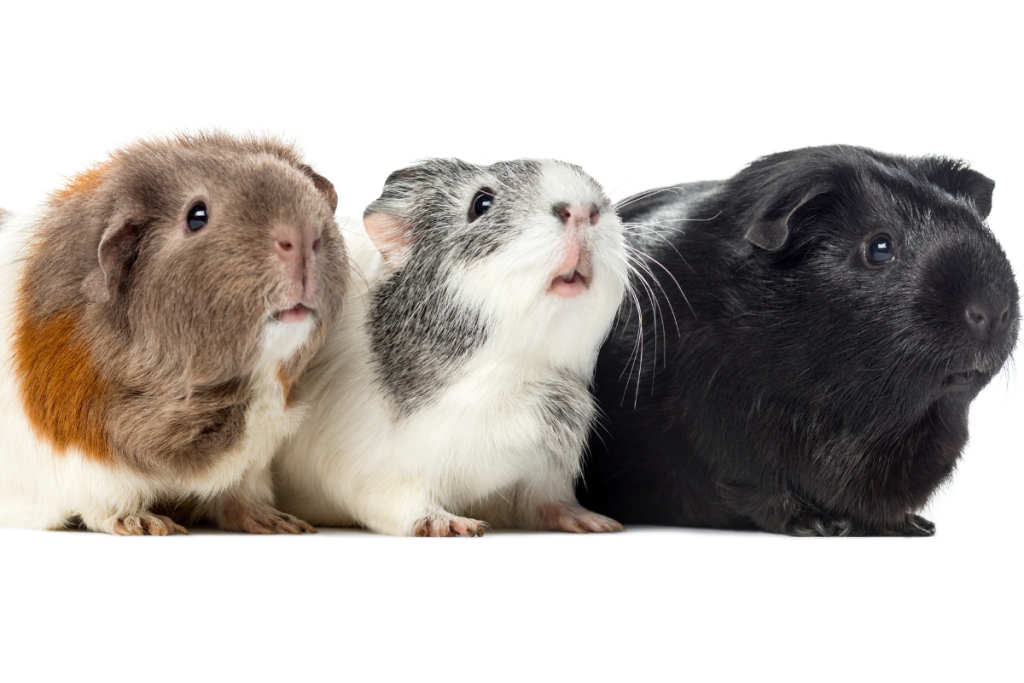
Solid
Solid guinea pig coloring is a coat color that is uniform throughout the guinea pig’s fur, without any distinctive patterns or markings. This coloring can range from white, cream, and beige to various shades of brown, gray, and black. Solid colored guinea pigs are often referred to by the name of their specific color, such as “white guinea pig” or “black guinea pig.”
Solid coloring is one of the most common types of guinea pig coloring, and many different breeds and varieties of guinea pigs can have solid coats. Some breeds with solid coats include the American, Peruvian, and Teddy guinea pigs. Solid colored guinea pigs can make great pets and are often sought after for their simple and elegant appearance.
Self
Self-colored guinea pigs are those that have a solid coat of a single color throughout their body, with no other markings or patterns. The term “self-colored” is often used to describe solid-colored guinea pigs in the United Kingdom and Europe.
Common self-colored guinea pig colors include white, black, cream, and shades of brown and gray. Self-colored guinea pigs can have short or long hair, depending on their breed and variety.
Self-colored guinea pigs are often favored for their simple and elegant appearance. They can be found in many different breeds and varieties, including American, Peruvian, and Silkie guinea pigs. Overall, self-colored guinea pigs are a popular choice as pets due to their beautiful coloring and friendly personalities.
Tortoiseshell
Tortoiseshell guinea pig coloring is a type of coloring that is characterized by patches of black, orange, and white or cream fur. The patches are usually well-defined and can be of varying sizes and shapes. The black patches can range from deep black to dark brown, while the orange patches can range from bright orange to a light golden color.
Tortoiseshell coloring is more commonly seen in female guinea pigs, as it is linked to the X-chromosome. However, males can also exhibit tortoiseshell coloring if they have a genetic anomaly. In some countries, such as the United Kingdom and Europe, tortoiseshell coloring is often referred to as “brindle” coloring.
Tortoiseshell coloring is found in many different guinea pig breeds, including the American, Abyssinian, and Teddy guinea pigs. Tortoiseshell guinea pigs are often sought after as pets due to their unique and beautiful coloring.
Roan
Roan guinea pig coloring is a type of coloring that is characterized by a mix of colored and white hairs evenly distributed throughout the body. The colored hairs can be of varying shades, such as black, brown, and red, while the white hairs can range from pure white to off-white or cream.
Roan coloring can appear in different degrees, with some guinea pigs having more colored hairs and less white hairs, while others have more white hairs and less colored hairs. The degree of roan coloring can vary depending on the breed and variety of guinea pig.
Roan coloring is found in many different guinea pig breeds, including the American, Abyssinian, and Peruvian guinea pigs. Roan guinea pigs are often sought after as pets due to their unique and striking appearance.
Dalmatian
Dalmatian guinea pig coloring is a type of coloring that is characterized by a white base coat with black or dark brown spots, much like the coat of a Dalmatian dog. The spots can be of varying sizes and shapes, and can be evenly or unevenly distributed throughout the body.
Dalmatian coloring is more commonly seen in short-haired guinea pig breeds, such as the American and Abyssinian guinea pigs. However, it can also appear in long-haired breeds such as the Peruvian and Silkie guinea pigs.
Dalmatian guinea pigs are highly sought after as pets due to their unique and eye-catching appearance. However, it’s important to note that their breeding can sometimes lead to health issues such as deafness, so it’s important to obtain them from reputable breeders who prioritize the health and well-being of their animals.
Himalayan
Himalayan guinea pig coloring is a type of coloring that is characterized by a white or cream-colored base coat, with dark pigmentation on the nose, feet, and ears. The dark pigmentation can be black, brown, or dark gray.
Himalayan coloring is a type of colorpoint coloring, which means that the darker pigmentation is restricted to certain areas of the body. This type of coloring is caused by a temperature-sensitive gene, which causes the pigmentation to develop only in areas where the temperature is cooler, such as the extremities of the body.
Himalayan guinea pigs are known for their distinct appearance and are often sought after as pets due to their striking coloring and sweet temperament. However, they can be more sensitive to cold temperatures due to their lack of pigmentation on their body and may require additional care in colder climates.
Dutch
Dutch guinea pigs have a distinct coloring pattern that is characterized by a white base coat with a solid-colored patch on their head, back, and rump. The color of the patch can be black, brown, chocolate, cream, gold, or any other solid color. The patch is usually symmetrical, with a clear dividing line between the white and colored sections.
The Dutch coloring pattern is a result of a dominant gene that is responsible for the specific distribution of pigmentation. Dutch guinea pigs are known for their distinctive appearance and are a popular choice for pets due to their friendly nature and striking coloring. They are also often used in show competitions, where their unique coloring pattern is highly valued.
Fox guinea pigs
The term “fox guinea pig” typically refers to a guinea pig that has a coat with a combination of colors that resemble those of a fox.
This can include shades of brown, black, and white in various patterns.
There is no specific breed of guinea pig that is known as a “fox guinea pig”, but the term may be used to describe a guinea pig with a particular coat color or pattern.
It is important to note that guinea pigs are domesticated animals and their coloring is the result of selective breeding rather than natural selection in the wild.
Tan guinea pigs
Tan guinea pigs have a solid tan color over their entire body. The shade of tan can range from a light beige to a dark brown, and their fur is typically short and smooth. Tan coloring is a recessive trait, meaning that both parents must carry the gene for the coloration to be expressed in their offspring.
Tan guinea pigs can also have other markings or patterns, such as white spots or patches, but the majority of their coat will be solid tan. They are a popular breed for showing and make great pets due to their friendly personalities.
Tricolor guinea pigs
Tricolour guinea pigs have three distinct colors in their coat, which can be distributed in various patterns. The three colors can be any combination of black, brown, white, tan, and cream. The most common tricolour pattern is a combination of black, tan, and white, with black and tan patches over a white base coat.
The tricolour pattern is a result of complex genetics and is considered a relatively rare coloration in guinea pigs. The pattern can be seen in several different breeds, including American, Abyssinian, and Peruvian guinea pigs.
Tricolour guinea pigs can be a great choice for those looking for a unique and eye-catching pet. They are known for their friendly and social nature and make great companions. However, it’s important to note that the tricolour pattern is not an indication of breed purity, and guinea pigs with this coloration can come from a variety of backgrounds.
Guinea Pig Coat Types
Guinea pigs have several different coat types that can vary in length, texture, and pattern. Here are some of the most common coat types:
- Smooth: Smooth-coated guinea pigs have short, sleek fur that lies flat against their body. They are easy to groom and do not require much maintenance.
- Abyssinian: Abyssinian guinea pigs have a unique coat with several swirls or rosettes, which are tufts of fur that stick out in all directions. They require regular grooming to prevent matting and tangling.
- Peruvian: Peruvian guinea pigs have long, silky fur that grows continuously and can reach lengths of up to 20 inches. They require frequent grooming to prevent matting and tangling.
- Silkie: Silkie guinea pigs have soft, fluffy fur that is shorter than the Peruvian but longer than the smooth coat. They are easy to maintain and do not require frequent grooming.
- Teddy: Teddy guinea pigs have a dense, curly coat that is soft to the touch. They do not require as much grooming as the Abyssinian or Peruvian but still need to be brushed regularly to prevent matting.
- Rex: Rex guinea pigs have a short, dense, and wiry coat that is soft to the touch. They are low-maintenance and do not require as much grooming as other long-haired breeds.
- Hairless: Hairless guinea pigs, such as the Skinny Pig, have little to no fur and require special care to protect their sensitive skin from injury and irritation.
The different coat types not only affect the guinea pig’s appearance but also their grooming needs and overall care requirements. It’s important to research and choose a coat type that fits your lifestyle and level of commitment.
Satin guinea pigs
Satin guinea pigs have a shiny, silky coat due to a genetic mutation that affects the hair shaft.
The hair is thinner and more translucent than in other guinea pig breeds, which gives it a glossy, satin-like appearance.
Satin guinea pigs come in a variety of colors and patterns, including solid, agouti, tortoiseshell, and roan.
The satin gene can be combined with other coat types to produce a satin version of those coats, such as satin Abyssinian or satin Teddy.
Satin guinea pigs require regular grooming to keep their coat healthy and shiny, as their hair is more fragile than in other breeds.
“Lethal satin” is a term used to describe a genetic mutation found in some satin guinea pigs that can cause health issues. This mutation is also known as the “lethal gene” or the “lethal white gene”.
The lethal satin mutation affects the pigments in the guinea pig’s hair, causing it to be more fragile and prone to breakage. This can result in hair loss, skin irritation, and other health issues.
In addition, the lethal satin mutation can also cause skeletal defects and other developmental abnormalities in some cases. Guinea pigs with these defects often do not survive past birth or have a significantly reduced lifespan.
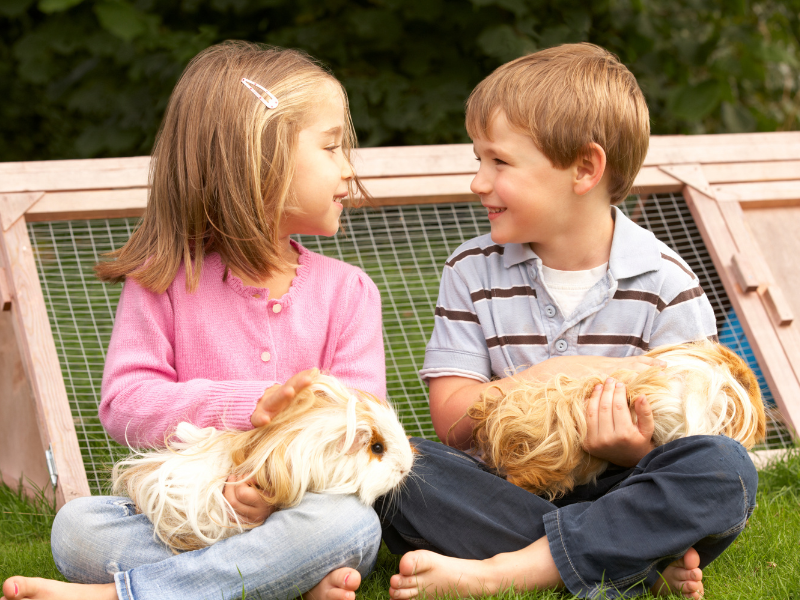
How to choose the right breed of guinea pig for your family
When choosing a breed of guinea pig, it is important to consider your lifestyle, preferences, and the characteristics of each breed.
Here are some factors to consider:
- Temperament: Different breeds of guinea pigs may have different personalities and temperaments. For example, some breeds may be more active and playful, while others may be more docile and calm. Consider what type of personality you are looking for in a pet.
- Coat type: Guinea pigs come in a variety of coat types, from short and smooth to long and curly. Consider whether you are willing to put in the time and effort to maintain a longer-haired guinea pig’s coat, as they will require more grooming.
- Size: Different breeds of guinea pigs come in different sizes, ranging from smaller breeds that weigh around one pound to larger breeds that can weigh up to three pounds. Consider how much space you have available for your pet.
- Availability: Some breeds of guinea pigs may be more readily available than others, depending on where you live and the availability of breeders or rescue organizations.
- Personal preference: Ultimately, choosing a breed of guinea pig is a personal preference. Consider what you find most appealing in terms of appearance and personality.
Once you have considered these factors, you can research the different breeds of guinea pigs and speak with breeders or rescue organizations to find the right breed for you.
Remember that each guinea pig has its own unique personality. It is important to choose a pet that you connect with and that fits well with your lifestyle.

